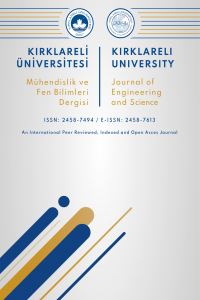TORBALAMA KARAR AĞACI TABANLI MAKINE ÖĞRENIMI KULLANARAK GÜNEŞ IŞINIMI TAHMİNİ
Yenilenebilir enerji, Makine öğrenmesi, Torbalama karar ağacı, Güneş ışınımı tahmini
SOLAR IRRADIANCE PREDICTION USING BAGGING DECISION TREE-BASED MACHINE LEARNING
___
- Akarslan, E., & Hocaoglu, F. O. A novel method based on similarity for hourly solar irradiance forecasting. Renewable Energy, 112, 337-346, 2017.
- Kamadinata, J. O., Ken, T. L., & Suwa, T. Sky image-based solar irradiance prediction methodologies using artificial neural networks. Renewable Energy, 134, 837-845, 2019.
- Dong, N., Chang, J. F., Wu, A. G., & Gao, Z. K. A novel convolutional neural network framework based solar irradiance prediction method. International Journal of Electrical Power & Energy Systems, 114, 105411, 2020.
- Tasnin, W., & Saikia, L. C. Deregulated AGC of multi-area system incorporating dish-Stirling solar thermal and geothermal power plants using fractional order cascade controller. International Journal of Electrical Power & Energy Systems, 101, 60-74, 2018.
- Almonacid, F., Pérez-Higueras, P. J., Fernández, E. F., & Hontoria, L. A methodology based on dynamic artificial neural network for short-term forecasting of the power output of a PV generator. Energy Conversion and Management, 85, 389-398, 2014
- Gutierrez-Corea, F. V., Manso-Callejo, M. A., Moreno-Regidor, M. P., & Manrique-Sancho, M. T. Forecasting short-term solar irradiance based on artificial neural networks and data from neighboring meteorological stations. Solar Energy, 134, 119-131, 2016.
- Aljanad, A., Tan, N. M., Agelidis, V. G., & Shareef, H. Neural network approach for global solar irradiance prediction at extremely short-time-intervals using particle swarm optimization algorithm. Energies, 14(4), 1213, 2021.
- Feng, Y., Gong, D., Zhang, Q., Jiang, S., Zhao, L., & Cui, N. Evaluation of temperature-based machine learning and empirical models for predicting daily global solar radiation. Energy Conversion and Management, 198, 111780, 2019.
- Rai, A., Shrivastava, A., & Jana, K. C. A CNN‐BiLSTM based deep learning model for mid‐term solar radiation prediction. International Transactions on Electrical Energy Systems, 31(9), e12664, 2021.
- Aslam, M., Lee, J. M., Kim, H. S., Lee, S. J., & Hong, S. Deep learning models for long-term solar radiation forecasting considering microgrid installation: A comparative study. Energies, 13(1), 147, 2019.
- Lee, J., Wang, W., Harrou, F., & Sun, Y. Reliable solar irradiance prediction using ensemble learning-based models: A comparative study. Energy Conversion and Management, 208, 112582, 2020.
- Xu, M., Watanachaturaporn, P., Varshney, P. K., & Arora, M. K. Decision tree regression for soft classification of remote sensing data. Remote Sensing of Environment, 97(3), 322-336, 2005.
- Lu, H., & Ma, X. Hybrid decision tree-based machine learning models for short-term water quality prediction. Chemosphere, 249, 126169, 2020.
- Breiman, L. Bagging predictors. Machine learning, 24(2), 123-140, 1996.
- Buhlmann P, Yu B. Analyzing bagging. Ann Stat 30:927–61, 2002.
- Prasad, A. M., Iverson, L. R., & Liaw, A. Newer classification and regression tree techniques: bagging and random forests for ecological prediction. Ecosystems, 9(2), 181-199, 2006.
- Kovačević, M., Ivanišević, N., Petronijević, P., & Despotović, V. Construction cost estimation of reinforced and prestressed concrete bridges using machine learning. Građevinar, 73(01.), 1-13, 2021.
- Harrou, F., Saidi, A., & Sun, Y. Wind power prediction using bootstrap aggregating trees approach to enabling sustainable wind power integration in a smart grid. Energy Conversion and Management, 201, 112077, 2019.
- ISSN: 2458-7494
- Yayın Aralığı: Yılda 2 Sayı
- Başlangıç: 2015
- Yayıncı: Kırklareli Üniversitesi
GÖZLÜK CAMLARINDA IŞIK GEÇİRGENLİK ÖZELLİKLERİ
BAZI FARK DENKLEMLERİNİN AYARLANMIŞ JACOBSTHAL-PADOVAN SAYILARI İLE İLİŞKİLİ TAM ÇÖZÜMLERİ
TORBALAMA KARAR AĞACI TABANLI MAKINE ÖĞRENIMI KULLANARAK GÜNEŞ IŞINIMI TAHMİNİ
Faz Değiştiren Malzemeler: Çeşitleri, Özellikleri ve Binalarda Kullanımları
Fatih Selim BAYRAKTAR, Ramazan KÖSE
ÇOKLU KUANTUM TEL KUYULARINDA ELEKTRİK ALAN VE MANYETİK ALAN’IN ELEKTRONİK ÖZELLİKLERE ETKİSİ
BİYOMEKANİK ANALİZDE YÜK KALDIRMA HAREKETİ YAKALAMA YÖNTEMLERİ VE ÖRNEK UYGULAMA
Melih CANLIDİNÇ, Mustafa GÜLEŞEN
ENTEGRE GÜNEŞ KOMBİNE ÇEVRİM SANTRALİNİN YAPISI VE ENERJİ ÜRETİMİNİN DEĞERLENDİRİLMESİ
BİTKİ PATOJENİ ALTERNARIA TENUISSIMA’YA KARŞI BAZI BİTKİ EKSTRAKTLARININ IN VITRO ETKİNLİĞİ
